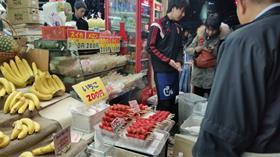
Japan’s Ministry of Finance has released official import statistics for 2015, with bananas, pineapples and grapefruit leading fruit imports in terms of volume, while bananas, kiwifruit and avocados led in terms of value.
While the total volume of fruit imported dropped slightly from 1.596m tonnes in 2014 to 1.566m tonnes in 2015, the import value rose 19 per cent on the previous year to ¥101,901m.
Kiwifruit has been a rising star in Japan’s fresh fruit import market, accounting for 5 per cent in terms of quantity and 13.4 per cent in terms of value in 2015. Some 79,000 tonnes of kiwifruit was imported in 2015, worth ¥18,577m.
Kiwifruit made “remarkable progress” in 2015, said Jack Moriya, president of leading Japanese trader Tokyo Seika.
“Kiwifruit promotions focusing on it nutritional value and health benefits of kiwifruit consumption has kept the kiwifruit market stable and on the rise,” Moriya said. “For Japanese retailers, better understanding of the price, supply and quality situation in advance has made it easier for them to manage and control; nevertheless, it is difficult to predict how Japanese consumers will react to future price increases.”
Imports of bananas dropped from 10,79 thousand tonnes to 959,000 tonnes in 2015 after peaking during the banana diet craze of 2008/09.
Household consumption drops
Japan’s household consumptipn of fruit has dropped to 78.17kg per household, the lowest in 15 years. During the same period, the purchasing price per household rose to ¥462 per kg, the highest it was been.
“Consumption of fresh fruit has trended downward for some time now,” Moriya said. “It can be attributed to some extent to higher prices, especially with the weak state of the Japanese economy.
“It could be generational as well as the young populace in Japan in particular like the convenience of fresh cut fruit where sales have been on the rise.”
Household consumption and expenditure on fresh citrus in particular is showing no signs of increasing in Japan.
“Whether it be oranges or grapefruit, citrus continues to travel in a downward trajectory with household consumption and expenditures down again, and purchasing prices up. Promotional efforts have not stemmed the tide. Any recovery in the marketplace is not expected any time soon if ever.”
Grapefruit imports also dropped from 272,000 tonnes 15 years ago to 101,000 tonnes.



